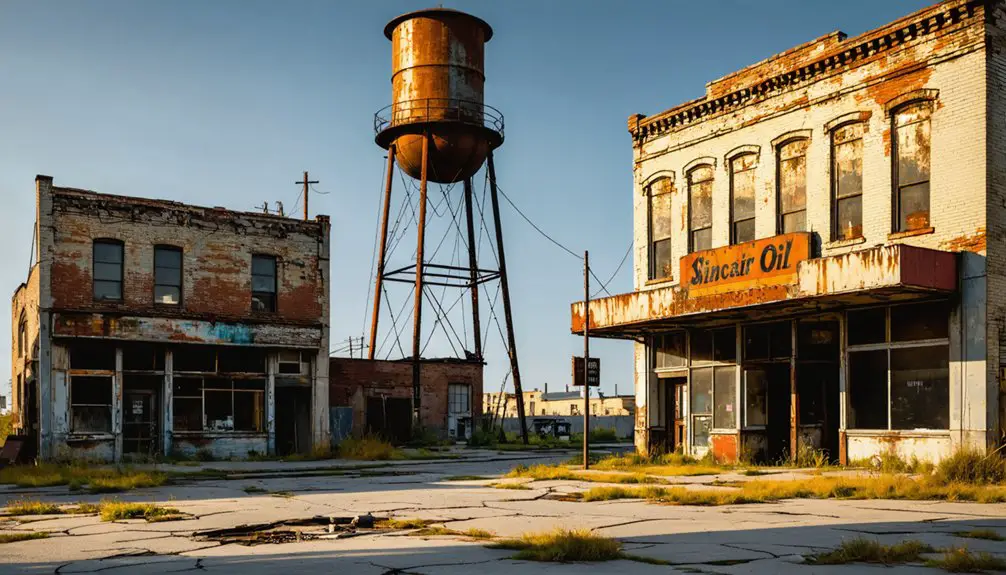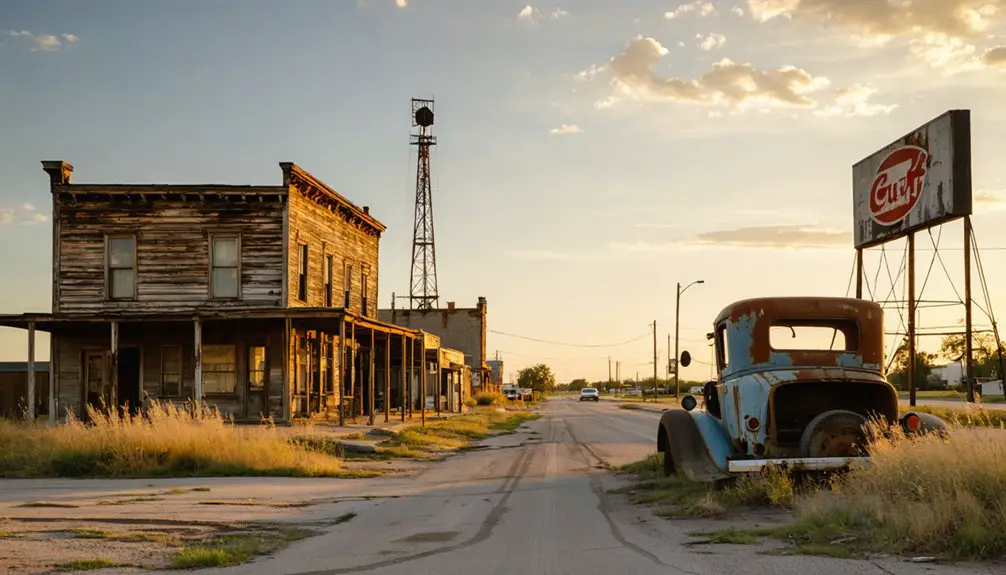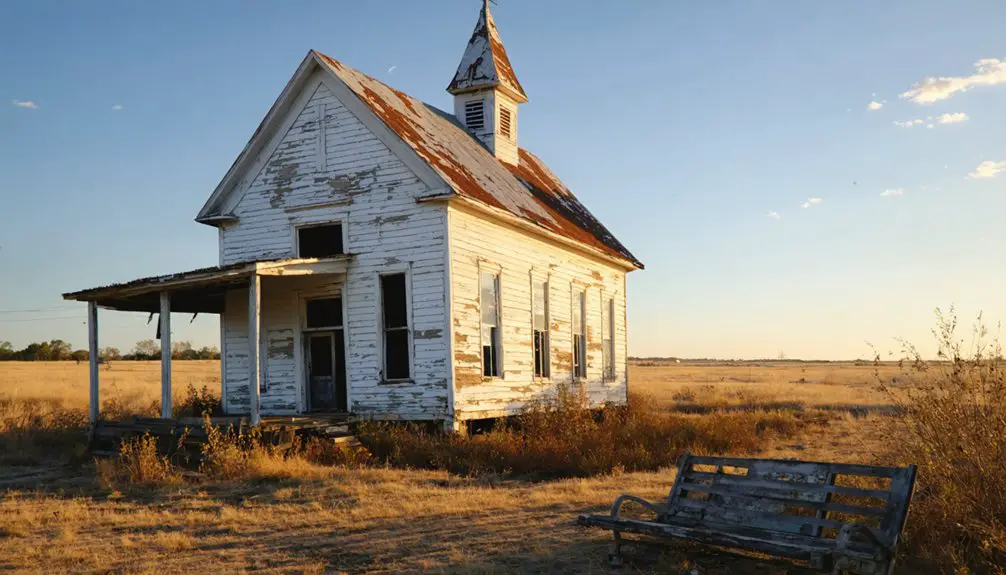You’ll find the ghost town of Wirt three miles west of Healdton, Oklahoma, where a once-bustling oil settlement emerged from humble beginnings as “Ragtown” in 1913. After striking oil, the town quickly grew to include a post office, schools, theaters, and stores. Devastating fires and declining oil production led to its eventual abandonment. Today, scattered remnants and weathered foundations hint at Wirt’s oil-rich past, with each crumbling structure telling a deeper story of Oklahoma’s petroleum heritage.
Key Takeaways
- Wirt, Oklahoma began in 1913 as “Ragtown” near the Wirt Franklin No. 1 oil well, quickly growing into a thriving oil boomtown.
- The town flourished during the oil boom with schools, churches, theaters, and stores, producing 320 million barrels by mid-century.
- Multiple devastating fires destroyed key buildings throughout Wirt’s history, significantly contributing to the town’s eventual decline.
- Economic downturn followed the depletion of oil resources, causing businesses to close and residents to leave in search of opportunities.
- Today, only scattered remnants remain, including an abandoned post office and deteriorating foundations, marking Wirt’s oil-rich past.
From Ragtown to Wirt: The Birth of an Oil Boom Town
When oil workers flooded into Carter County, Oklahoma in 1913, they established a makeshift settlement of tents and shanties that locals dubbed “Ragtown.”
Located three miles west of Healdton, this rudimentary camp sprang up practically overnight as news spread of the Wirt Franklin No. 1 well‘s discovery of the expansive Healdton oilfield.
You’ll find that Ragtown‘s origins reflected the raw, enterprising spirit of early Oklahoma oil exploration.
As Crystal Oil Company’s wildcat well proved successful, independent operators rushed to tap into what became known as the “poor man’s field.”
The settlement’s transformation from tent city to proper town came quickly, providing shelter and work for hundreds of oil-field workers seeking opportunity.
The area would go on to yield an impressive 320 million barrels of crude oil by the middle of the century.
The settlement’s transformation from tent city to proper town came quickly.
Life in a Thriving Petroleum Community
Life in Wirt revolved around the demanding rhythms of oil production, with workers adapting to harsh conditions and primitive equipment as they chased petroleum riches.
The Crystal Oil Company well launched the initial rush of drilling activity in 1913. You’d find roustabouts, drillers, and engineers living in makeshift camps near drilling sites, fostering a strong sense of worker solidarity amid shared hardships. The transient lifestyles of wildcatters and laborers kept the town’s population in constant flux, though some put down roots as general stores, schools, and churches emerged. Following the example of Jack Abernathy, many companies began offering insurance and retirement benefits to their field workers.
You’d witness a diverse mix of people, from independent oilmen to Native American landowners, all maneuvering the economic opportunities and challenges of the boom.
Halliburton’s innovative well-cementing techniques and Arutunoff’s submersible pumps transformed daily operations, while supporting businesses sprang up to serve the growing community’s needs.
Economic Peak and Infrastructure Development
You’d find Wirt at its economic peak during the oil boom, when petroleum prosperity attracted workers and their families to this bustling Carter County community.
The town’s growth brought essential infrastructure including a post office, multiple churches, two gas stations, and various retail establishments that served both permanent residents and transient oil workers. For historical clarity and proper navigation, many records about Wirt’s infrastructure are found in place name disambiguation resources.
A local school, movie theater, drug store, and competing grocery stores showcased Wirt’s transformation from an informal “Ragtown” of tents into a well-established community. Like many resource-dependent towns, Wirt’s fate ultimately followed the pattern of Oklahoma’s numerous boomtowns that declined when their economic foundations disappeared.
Oil Industry Prosperity
The discovery of the Wirt Franklin No. 1 well in August 1913 transformed the sleepy Oklahoma plains into a bustling oil region, marking the beginning of the Healdton field’s remarkable prosperity.
Like many other early wildcatters in Oklahoma, these pioneering oilmen took significant risks in their pursuit of black gold.
You’d have witnessed the incredible community resilience as locals and newcomers alike seized opportunities in oil exploration, with initial wells producing 25 barrels daily and later wells reaching up to 5,000 barrels.
The martial law declaration in 1936 showed how seriously the state took drilling disputes and production regulations.
The field’s success drew ambitious independent producers, earning it the nickname “the poor man’s field” due to shallow depths and low drilling costs.
By mid-century, the Greater Healdton-Hewitt oilfield had produced 320 million barrels across its 22-mile expanse.
You’d have seen the region’s infrastructure expand rapidly, with new railroads from Ardmore supporting the booming towns of Wilson and Ringling, while innovative well-cementing techniques revolutionized the industry’s capabilities.
Community Growth Period
As oil wealth poured into the region, Wirt evolved from a collection of worker tents known as “Ragtown” into a thriving community with permanent structures and modern amenities.
The population dynamics shifted dramatically as oil workers and their families established roots, creating demand for essential services and infrastructure. Like many communities during the oil boom of 1920s, the town experienced a period of remarkable prosperity and growth.
The community’s resilience showed in its expanding business district, which featured two grocery stores, a drug store, and a bank. Similar to the Main Street of America, the town’s main thoroughfare bustled with commercial activity.
You would’ve found a self-sufficient town with two churches, a local school, and a post office serving as the communication hub.
For entertainment, you could catch a show at the local movie theater.
The town’s strategic location, just three miles from Healdton, strengthened its position as a bustling oil boom community with two gas stations supporting the region’s transportation needs.
Local Business Expansion
During Wirt’s economic peak, every corner of the bustling oil town showcased the rapid expansion of commercial ventures catering to its growing population.
You’d find remarkable business diversity, from essential services to entertainment venues, all driven by the petroleum boom‘s prosperity. The town’s retail evolution transformed what was once “Ragtown” into a proper commercial hub.
You could do your banking, catch a movie, fill up at two gas stations, or shop at multiple grocery stores – all within this thriving community.
The presence of a drug store and two churches further reflected Wirt’s development beyond just an oil camp. These establishments served the daily needs of oil workers and their families, creating a self-sustaining local economy that defined Wirt’s golden age.
The Forces Behind the Town’s Decline

You’ll find that Wirt’s decline followed a familiar pattern of Oklahoma ghost towns, as the local oil economy faltered and residents began moving away in search of better opportunities.
The town’s infrastructure took a devastating blow when fires destroyed several buildings, including the town’s hotel and many businesses along Main Street.
These disasters, combined with the economic downturn, accelerated the exodus of residents and sealed Wirt’s fate as another Oklahoma ghost town.
Economic Forces Trigger Exodus
While the discovery of oil initially transformed Wirt from a collection of workers’ tents into a bustling boomtown, the community’s heavy dependence on petroleum would ultimately spell its downfall.
The town’s economic dependency on a single industry left it vulnerable when oil production began to decline. You’d have seen businesses shuttering one by one as the customer base dwindled, with the bank, theater, and stores becoming unsustainable.
Poor resource management and lack of economic diversification made recovery impossible. When the oil wells stopped producing, workers left in droves, triggering a devastating chain reaction.
Each closure and departure weakened the town’s economic foundation further, while shifting transportation routes and regional market changes directed commerce elsewhere. The pattern you see in Wirt mirrors many Oklahoma ghost towns that rose and fell with their resource booms.
Fires Devastate Local Infrastructure
Beyond the economic challenges that plagued Wirt, devastating fires repeatedly ravaged the town’s infrastructure throughout its history, accelerating its descent into abandonment.
The town’s rapid growth during the oil boom created conditions ripe for disaster, with closely packed wooden structures and limited fire safety measures in place.
You’ll find that fires systematically destroyed significant community pillars – the school, movie theater, drug store, and multiple gas stations fell victim to the flames.
Despite initial attempts at community resilience through reconstruction, the frequency of fires depleted resources and willpower to rebuild.
The lack of adequate firefighting infrastructure and dwindling population made each blaze more devastating than the last.
As essential services vanished in smoke, residents and businesses relocated to more stable neighboring towns.
What Remains: A Journey Through Time
Although fires and economic decline have erased much of Wirt’s former glory, today’s visitors will find only scattered remnants of this once-bustling Oklahoma oil town.
Your remnants exploration will reveal few intact structures from the boom era, with most original buildings, including the theater, bank, and stores, having succumbed to time and flames.
The post office, established in 1914, stands silent, while former churches and schools have long ceased operation.
Time has silenced the post office, churches, and schools that once gave life to this forgotten town.
You’ll notice the historical significance in the weathered foundations and overgrown lots that hint at Wirt’s oil-rich past.
Named after oilman Wirt Franklin, who drilled the first well here, the town’s remaining features tell a familiar story of boom-and-bust that shaped many Oklahoma communities.
The quiet landscape has largely returned to nature, with minimal evidence of its former prosperity.
Legacy of Oklahoma’s Oil Heritage

Since Oklahoma’s first accidental oil discovery near Salina in 1859, the state’s petroleum industry has shaped its economic and cultural destiny.
You’ll find this oil heritage deeply woven into Oklahoma’s story, from the pioneering Nellie Johnstone Number One well in 1897 to the state’s reign as America’s leading oil producer by 1907.
Through decades of boom and bust, the industry transformed small towns into bustling cities, with Bartlesville and Oklahoma City standing as symbols of community resilience.
By 1927, production soared to 762,000 barrels daily, fueling unprecedented prosperity across the region.
Even today, Oklahoma’s petroleum legacy endures, ranking fifth in U.S. oil production as of 2014, with 610 million barrels in proven reserves continuing to influence the state’s economic future.
Frequently Asked Questions
Are There Any Oil Wells Still Operating Near Wirt Today?
You’ll find active oil production continues near Wirt today, with Ovintiv running multiple rigs and modern drilling operations in the Anadarko Basin, bringing 25-35 new wells online throughout 2025.
What Was the Peak Population of Wirt During the Oil Boom?
While a million dreams once filled this boomtown, you won’t find exact population records for Wirt’s peak during the oil boom – though its multiple stores, theaters, and churches suggest hundreds of residents.
Did Any Famous People or Historical Figures Live in Wirt?
Besides oil businessman Wirt Franklin, who gave the town its name and drilled its first well, you won’t find any famous residents or nationally significant historical figures in this former boomtown.
Can Visitors Legally Explore the Remaining Structures in Wirt?
Like a locked door guards its treasures, you can’t legally explore Wirt’s remaining structures without permission. Most buildings are on private property, and you’ll need owner consent to avoid trespassing violations.
Were There Any Notable Crimes or Lawlessness During Wirt’s Boom Years?
While you’d expect high crime rates in an oil boomtown, there’s no documented evidence of major lawlessness or specific criminal events during Wirt’s heyday, despite typical challenges with limited law enforcement.
References
- https://en.wikipedia.org/wiki/List_of_ghost_towns_in_Oklahoma
- https://en.wikipedia.org/wiki/Wirt
- https://gateway.okhistory.org/ark:/67531/metadc2016960/m1/11/
- https://www.ghosttowns.com/states/ok/wirt.html
- https://www.oklahomahistory.net/newsletters/TT1146.htm
- https://dp.la/item/56be7997e21e28dcde5c887ee45c6caf
- https://aoghs.org/petroleum-pioneers/halliburton-and-healdton-oilfield/
- https://www.okhistory.org/publications/enc/entry?entry=PE023
- https://aoghs.org/this-week-in-petroleum-history/august-4-2025/
- https://samnoblemuseum.ou.edu/permanent-exhibits/conoco-oil-pioneers-of-oklahoma-plaza/



